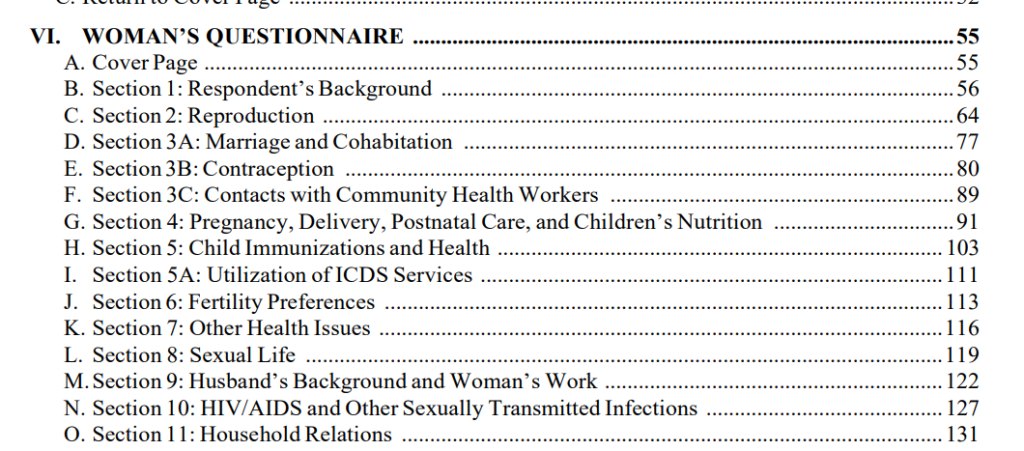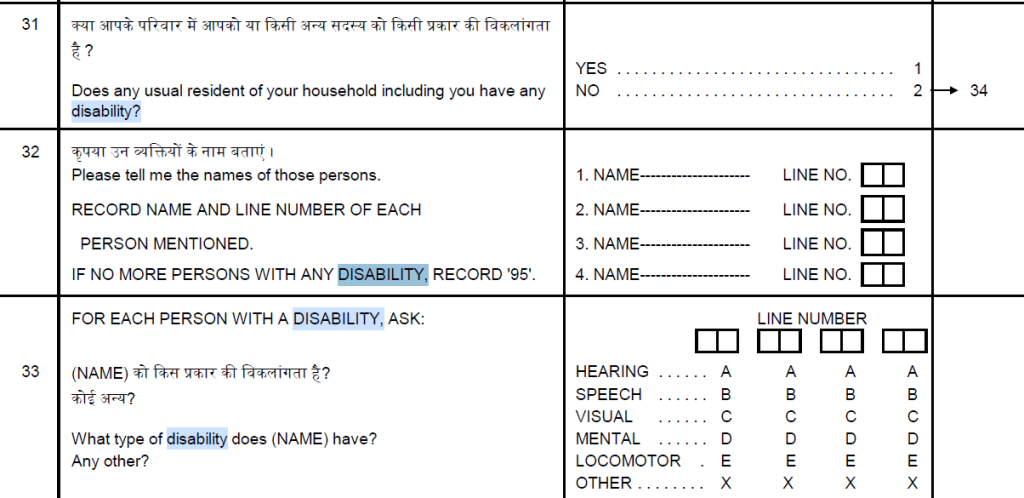The announcement in May that the National Family Health Survey, scheduled for 2023-’25, has dropped survey questions on disability on technical grounds has come as a major blow to the disability sector in India. The sector already struggles to access data about disability relating to themes such as education, public health and employment.
Data from the NFHS—one of the largest household surveys in the world—is crucial for effective policy interventions for people with disability and helps design better welfare programmes.
It allows researchers to determine critical information about people with disabilities such as their geographical distribution, their ages, genders and educational levels.

It also makes it possible to generate insights into otherwise under-researched areas such as disability and HIV/AIDS, disability and sexual life, disability, and gender, disability and maternity, disability and general well-being.
Several of the data points collected under the NFHS are not covered by other surveys or databases. For instance, no other surveys in India can provide data on tuberculosis. In the absence of disability disaggregation under the NFHS, there is no way of finding out how many persons with disabilities have tuberculosis, hepatitis B or C.
The NFHS was first conducted in 1992 to collect data on health and nutrition and family planning with a focus on women and children. Questions pertaining to disability were first included in the NFHS-5 conducted between 2019 and 2021.
To give a sense of intersectional data that can be unlocked from it, areas covered under the men’s and women’s questionnaires of NFHS-5 are featured in figures 1 and 2 below:


Such data is crucial for designing better services. In addition, since the survey is being conducted once in three years, disability questions make it possible to track the progress of health indicators of people with disabilities.

Even though the NFHS-5 survey contained questions about disability, all the data was not released. The main reason was that disability data collected through the survey was not accurate and might result in wrong estimates. Another reason was that surveyors are not equipped to check medical certificates and record disability. Besides, understanding the disability question was cited to be a challenge in itself.
But is it really a challenge? Are there alternate opportunities to capture disability numbers?
Three questions numbered 31, 32, and 33 pertain to disability in NFHS-5, as can be seen from Figure 3:

The questions are simple and uncomplicated. Further, the process under NFHS-5 did not entail the checking of disability certificates. The identification of disability was through self-reporting based on the definitions of disabilities. These definitions, as provided in the interviewer’s manual, are as follows, in Figure 4:

The interviewer’s manual for NFHS-5 guides the interviewers to approach the questions with sensitivity, and suggests that the interviewer initiate the conversation by telling respondents how disability data can help the government in planning for their welfare. However, the definitions on which the self-reporting is done have some limitations.
First, the definitions are oriented toward the “medical model” of disability disregarding the “social model” and functional limitations. Second, though the definitions are not too complicated, they can lead to confusion if the interviewer is not adequately trained. Third, there is a chance that respondents find it difficult to comprehend the definitions in responding to the questions.
Such confusion can lead either to over-reporting or under-reporting of disabilities. Thus, the apprehension about inaccurate data cannot be ruled out. Despite these limitations of the data collection process, dropping disability from NFHS-6 is a lost opportunity.

Are there any channels for disability data collection in health?
With disability questions being dropped from the NFHS-6, discussing potential options to generate similar disability data is crucial. Here, three potential channels could be: a) developing a separate health survey specifically for persons with disabilities b) modifying existing disability-specific surveys to include data points that were originally covered through NFHS-5 and c) including disability data as part of other existing general data collection initiatives.
The first channel, though ideal, presents challenges. Designing a survey from scratch involves intensive inputs including technical resources to design the survey and train the data collectors, pilots and iterative steps toward improving the survey, and a long-drawn process to obtain executive and administrative approvals and budgets.
Further, the approach where data on persons with disabilities is collected separately makes it difficult to draw comparative inferences between the segment of the population that has disabilities and the segment that does not. This might become a problem especially when it comes to designing welfare policies meant for the general population that also need to cater to the population living with disabilities.
With respect to the second option, one must take into account that no other existing survey has a sample size or health data coverage as extensive as the NFHS. The sample for NFHS-5 was 7,24,115 women and 1,01,839 men in 636,699 households. In the upcoming NFHS-6, the number of interviews is expected to be about 7,45,488 women and 1,19,501 men in 670,032 households.
Most of the variables in NFHS are unique. The National Sample Survey’s Persons with Disabilities Survey, which is the only disability-specific survey in India, includes a very limited number of questions on the health and well-being indicators covered by the NFHS. Though the National Sample Survey questionnaire could be extended to include a health module, it will be a resource-intensive exercise. Besides, the National Sample Survey for persons with disability is not conducted at specified time intervals.
The last option is an opportunity to strengthen the quality of disability data in general, and not just at the intersection of disability and health. This could be through any data collection initiative, even pooling programme-specific data collection by civil society initiatives or scheme-implementation data by the government.
But data in disability is known to be a challenge. To address this, the draft disability policy released in 2022 envisaged the Unique Disability ID project as an opportunity to develop a national-level database on people with disability. This database when linked with all service delivery mechanisms could provide real-time data on Persons with Disability.
Though the Unique Disability ID promises to become the backbone of the disability data ecosystem in India, persons with disabilities are facing challenges in availing of the cards owing to a lack of awareness, confusion around the process, administrative delays, and backlogs.
Dropping the disability question will impede the scope of evidence-based disability-related policy decisions. It will also limit India’s ability to track progress toward the Sustainable Development Goals and achievement of the “no-person left behind” goal by 2030.
Though there is no straightforward, short-term path to overcoming the data gap resulting from the dropping of NFHS disability questions, evolving dependable mechanisms for disability data collection and disaggregation will remain integral to fostering meaningful inclusion for persons with disabilities.
This article was originally published on Scroll.in.





